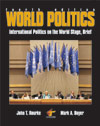Due to the size of these maps, downloading them is recommended. Click on the links below or download these files to view these maps.  World Religions (475.0K) World Religions (475.0K)
This web map illustrates the predominate religions in different regions of the world. Religious adherence is one of the fundamental defining characteristics of culture. A depiction of
the spatial distribution of religions is, therefore, as close as we can come to a map of cultural
patterns. More than just a set of behavioral patterns having to do with worship and ceremony, religion
is an important conditioner of the ways that people treat one another and the environments that
they occupy. In many areas of the world, the ways in which people make a living, the patterns of
occupation that they create on the land, and the impacts that they make on ecosystems are the
direct consequence of their adherence to a religious faith.
 World Languages (472.0K) World Languages (472.0K)
This web map illustrates the predominate languages in different regions of the world. Like religion, language is an important defining characteristic of culture. It is perhaps
the most durable of all cultural traits. Even after centuries of exposure to
other languages or even of conquest by speakers of other languages, the speakers of a specific
tongue will often retain their own linguistic identity. As a geographic element, language helps us
to locate areas of potential conflict, particularly in regions where two or more languages
overlap. Many, if not most, of the world's conflict zones are also areas of linguistic diversity.
Language also provides clues that enable us to chart the course of human migrations, as shown in the
distribution of Indo-European languages. And it helps us to understand some of the reasons behind
important historical events; linguistic identity differences played an important part in the
disintegration of the Soviet Union. | 


 2002 McGraw-Hill Higher Education
2002 McGraw-Hill Higher Education